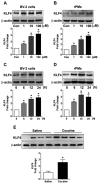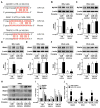Cocaine-Mediated Downregulation of miR-124 Activates Microglia by Targeting KLF4 and TLR4 Signaling
- PMID: 28478506
- PMCID: PMC5673594
- DOI: 10.1007/s12035-017-0584-5
Cocaine-Mediated Downregulation of miR-124 Activates Microglia by Targeting KLF4 and TLR4 Signaling
Abstract
Cocaine is known to activate microglia both in vitro and in vivo. High expression of microglial Toll-like receptors (TLRs) and their downstream signal transducers play critical roles in determining microglial activation status. Emerging reports have also demonstrated that cocaine can enhance the strength of TLR signaling. Detailed molecular mechanisms underlying this phenomenon, however, remain elusive. In this study, we investigated the role(s) of miR-124 in regulating microglial TLR4 signaling in the context of cocaine. Herein, we found a dose- and time-dependent upregulation of KLF4 in cocaine-exposed BV-2 cells and rat primary microglial cells (rPMs). KLF4 also identified as a novel 3'-UTR target directly regulated by miR-124. In parallel, miR-124 regulated multiple TLR4 signaling molecules including TLR4, MyD88, TRAF6, and IRAK1. Repeated doses of cocaine (20 mg/kg; i.p.) administration in mice for 7 days further validated the in vitro key findings. Also, miR-124 overexpression significantly blocked the cocaine-mediated upregulation of pro-inflammatory cytokines. In contrast, miR-124 overexpression notably increased the expression of anti-inflammatory mediators in cocaine-exposed microglial cells. Intriguingly, stereotactic administration of lentivirus-miR-124 in the striatum significantly inhibited cocaine-mediated microglial activation and locomotor hyperactivity in vivo. In summary, these findings implicate the role of miR-124 in regulating TLR4 signaling, thereby indicating a new pathway responsible for cocaine-mediated microglial activation.
Keywords: Cocaine; Microglial cells; MyD88; Neuroinflammation; TLR4; TRAF6; miR-124.
Conflict of interest statement
Figures







Similar articles
-
MicroRNA-181c negatively regulates the inflammatory response in oxygen-glucose-deprived microglia by targeting Toll-like receptor 4.J Neurochem. 2015 Mar;132(6):713-23. doi: 10.1111/jnc.13021. Epub 2015 Feb 12. J Neurochem. 2015. PMID: 25545945
-
MicroRNA-146a-5p Negatively Regulates Pro-Inflammatory Cytokine Secretion and Cell Activation in Lipopolysaccharide Stimulated Human Hepatic Stellate Cells through Inhibition of Toll-Like Receptor 4 Signaling Pathways.Int J Mol Sci. 2016 Jul 7;17(7):1076. doi: 10.3390/ijms17071076. Int J Mol Sci. 2016. PMID: 27399683 Free PMC article.
-
miR-451 elevation relieves inflammatory pain by suppressing microglial activation-evoked inflammatory response via targeting TLR4.Cell Tissue Res. 2018 Dec;374(3):487-495. doi: 10.1007/s00441-018-2898-7. Epub 2018 Aug 1. Cell Tissue Res. 2018. PMID: 30069596
-
MicroRNA in TLR signaling and endotoxin tolerance.Cell Mol Immunol. 2011 Sep;8(5):388-403. doi: 10.1038/cmi.2011.26. Epub 2011 Aug 8. Cell Mol Immunol. 2011. PMID: 21822296 Free PMC article. Review.
-
Targeting the TLR4 signaling pathway by polyphenols: A novel therapeutic strategy for neuroinflammation.Ageing Res Rev. 2017 Jul;36:11-19. doi: 10.1016/j.arr.2017.02.004. Epub 2017 Feb 21. Ageing Res Rev. 2017. PMID: 28235660 Review.
Cited by
-
Role of Inflammasomes in HIV-1 and Drug Abuse Mediated Neuroinflammaging.Cells. 2020 Aug 8;9(8):1857. doi: 10.3390/cells9081857. Cells. 2020. PMID: 32784383 Free PMC article. Review.
-
Biogenesis, physiological functions and potential applications of extracellular vesicles in substance use disorders.Cell Mol Life Sci. 2021 Jun;78(11):4849-4865. doi: 10.1007/s00018-021-03824-8. Epub 2021 Apr 5. Cell Mol Life Sci. 2021. PMID: 33821293 Free PMC article. Review.
-
The Effect of SPTLC2 on Promoting Neuronal Apoptosis is Alleviated by MiR-124-3p Through TLR4 Signalling Pathway.Neurochem Res. 2019 Sep;44(9):2113-2122. doi: 10.1007/s11064-019-02849-7. Epub 2019 Aug 1. Neurochem Res. 2019. PMID: 31372925
-
Extracellular vesicles as carriers for noncoding RNA-based regulation of macrophage/microglia polarization: an emerging candidate regulator for lung and traumatic brain injuries.Front Immunol. 2024 Mar 15;15:1343364. doi: 10.3389/fimmu.2024.1343364. eCollection 2024. Front Immunol. 2024. PMID: 38558799 Free PMC article. Review.
-
Morphine-mediated release of miR-138 in astrocyte-derived extracellular vesicles promotes microglial activation.J Extracell Vesicles. 2020 Oct;10(1):e12027. doi: 10.1002/jev2.12027. Epub 2020 Nov 19. J Extracell Vesicles. 2020. PMID: 33304479 Free PMC article.
References
-
- Pedras-Vasconcelos J, Puig M, Verthelyi D. TLRs as therapeutic targets in CNS inflammation and infection. Front Biosci (Elite Ed) 2009;1:476–487. - PubMed
MeSH terms
Substances
Grants and funding
LinkOut - more resources
Full Text Sources
Other Literature Sources

